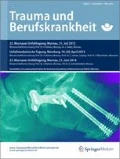Zusammenfassung
Die Arthrose des oberen Sprunggelenks (OSG) ist überwiegend posttraumatisch bedingt und betrifft damit häufig jüngere, aktive Patienten. Darüber hinaus treten oft Begleitverletzungen mit Weichteilschädigungen und Achsfehlstellungen auf. Bei hochgradiger Arthrose stellt die Arthrodese ein etabliertes Verfahren mit nahezu unbegrenzter Anwendungsmöglichkeit und sicherer Schmerzfreiheit dar. Durch die Weiterentwicklung der OSG-Totalendoprothese (OSG-TEP) ist bei Erfüllung individueller Indikationskriterien eine gute Alternative zur Arthrodese entstanden, bei welcher das physiologische Gangbild weitgehend erhalten bleibt und Beinverkürzung und Anschlussarthrosen verhindert werden können. TEP-Wechsel und sekundäre Arthrodesen werden durch den minimalen Knochenverlust der heutigen Prothesengeneration erleichtert, sodass auch jüngeren Patienten die TEP empfohlen werden kann. Voraussetzung für ein optimales Ergebnis sind korrekte Achsverhältnisse und eine gute Weichteilbalancierung. Zusätzliche Eingriffe können ein- oder zweizeitig durchgeführt werden. Aufgrund der höheren Anwendungsbreite bleibt die Arthrodese der Goldstandard, die TEP wird bis zur Steigerung der Fallzahlen spezialisierten Zentren vorbehalten bleiben.
Abstract
Arthritis of the ankle is primarily posttraumatic and therefore found in younger, active patients. Accompanying injuries involving soft tissue damage and axial misalignment are often seen. In case of severe arthritis ankle arthrodesis is an established method with an almost unlimited spectrum of application which also results in reliable freedom from pain. Due to advances in total ankle replacement (TAR), and in cases where individual indications are fulfilled, TAR offers an excellent alternative to arthrodesis. Thus physiological gait can be almost completely maintained and shortening of the leg or development of arthritis in adjacent joints can be prevented. Since TAR and secondary fusion are facilitated by minimal bone loss using modern prostheses, the procedure can be recommended even in younger patients. Correct positioning and soft tissue balance, which should be performed secondarily, are preconditions for perfect results. Due to greater fields of application, arthrodesis remains the gold standard, whereas TAR will remain reserved for specialized centres until case numbers increase.




Literatur
Barton T, Lintz F, Winson (2011) Biomechanical changes associated with the osteoarthritic, arthrodesed, and prosthetic ankle joint. J Foot Ankle Surg 17:52–57
Buechel FF Sr, Buechel FF Jr, Pappas MJ et al (2003) Ten-year evaluation of cementless Buechel-Pappas meniscal bearing total ankle replacement. Foot Ankle Int 24:462–472
Charnley J (1951) Compression arthrodesis of the ankle and shoulder. J Bone Joint Surg Br 33B(2):180–191
Close JR, Inman VT, Poor PM, Todd FN (1967) The function of the subtalar joint. Clin Orthop Relat Res 50:159–179
Coester LM, Saltzman CL, Leupold J, Pontarelli W (2001) Long term results following ankle arthorodesis for post traumatic arthritis. J Bone Joint Surg Am 83:219–228
Dohm MP, Benjamin JB, Harrison J, Szivek J (1994) A biomechanical evaluation of three forms of internal fixation used in ankle arthrodesis. Foot Ankle Int 15:297–300
Espinosa N, Klammer G (2010) Treatment of ankle osteoarthritis: arthrodesis versus total ankle replacement. Eur J Trauma Emerg Surg 36:525–535
Fuchs S, Sandmann C, Skwara A, Chylarecki C (2003) Quality of life 20 yrs after arthrodesis of the ankle. A study of adjacent joints. J Bone Joint Surg Br 85:994–998
Haddad SL, Coetze JC, Estok RN et al (2007) Intermediate and long-term outcomes of total ankle arthroplasty and ankle arthrodesis. J Bone Joint Surg Am 89:1899–1905
Hansen ST (2005) Grundsätzliche Überlegungen zur Technik der Sprunggelenkarthrodese im Hinblick auf einen späteren Wechsel zur Sprunggelenkendoprothese. Oper Orthop Traumatol 17:563–568
Hintermann B, Dick W (2006) Arthrodese oder Prothese? Neue Aspekte in der endgradigen Arthrose des Sprunggelenks. Orthopade 35:487–488
Holz U (2006) Posttraumatische Arthrose: Arthrodese/Endoprothese Was ist zu empfehlen? Trauma Berufskrankh 8:20–25
Jerosch J, Fayaz H, Senyurt H (2006) Sprunggelenksarthrodese und Sprunggelenkprothetik – ein Vergleich. Orthopade 35:495–505
Kitaoka H, Crevoisier X, Hansen D (2006) Foot and ankle kinematics and ground reaction forces during ambulation. Foot Ankle Int 27(10):808–813
Kofoed H (2004) Scandinavian total ankle replacement. Clin Orthop Relat Res 424:473
Maurer F (2006) Verletzungen des oberen Sprunggelenkes – Arthrodese und OSG-Prothese. Diskussion mit dem Auditorium. Trauma Berufskrankh 8:26–27
Müller EJ, Wick M, Muhr G (1999) Chirurgische Therapie bei Inkongruenzen und Arthrosen am oberen Sprunggelenk. Orthopade 28:529–537
Piriou P, Culpan P, Mullins M et al (2008) Ankle replacement versus arthrodesis: a comparative gait analysis study. Foot Ankle Int 29:3–9
SooHoo NF, Zingmond DS, Ko CY (2007) Comparison of reoperation rates following ankle arthrodesis and total ankle arthroplasty. J Bone Joint Surg Am 89:2143–2149
Valderrabano V, Hintermann B, Nick BM, Stefanyshyn D (2003) Kinematic changes after fusion and total replacement of the ankle. Part 2: Movement transfer. Foot Ankle Int 24:888–896
Valderrabano V, Nick BM, Stefanyshyn D, Hintermann B (2007) Gait analysis in ankle osteoarthritis and total ankle replacement. Clin Biomech (Bristol, Avon) 22.904–944
Zwipp H (2010) Arthrodese vs. Gelenkersatz. Oberes Sprunggelenk. Trauma Berufskrankh 12:125–131
Interessenkonflikt
Der korrespondierende Autor gibt an, dass kein Interessenkonflikt besteht.
Author information
Authors and Affiliations
Corresponding author
Rights and permissions
About this article
Cite this article
Abt, HP., Neun, O., Zivko, G. et al. Posttraumatische Arthrose des oberen Sprunggelenks. Trauma Berufskrankh 13, 198–203 (2011). https://doi.org/10.1007/s10039-011-1746-8
Published:
Issue Date:
DOI: https://doi.org/10.1007/s10039-011-1746-8

